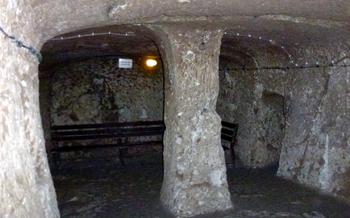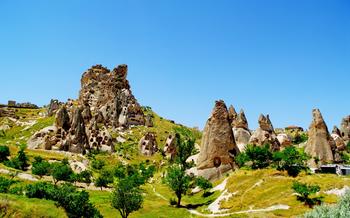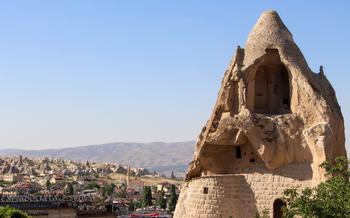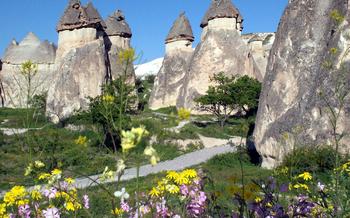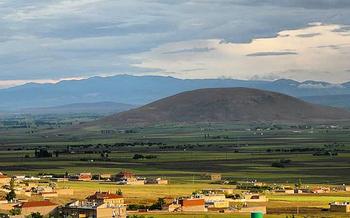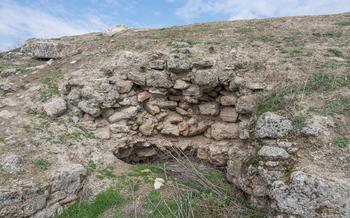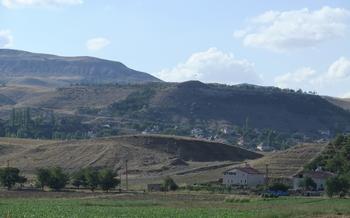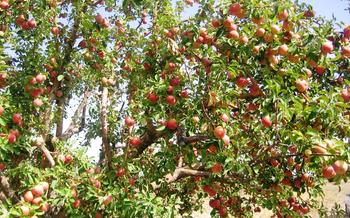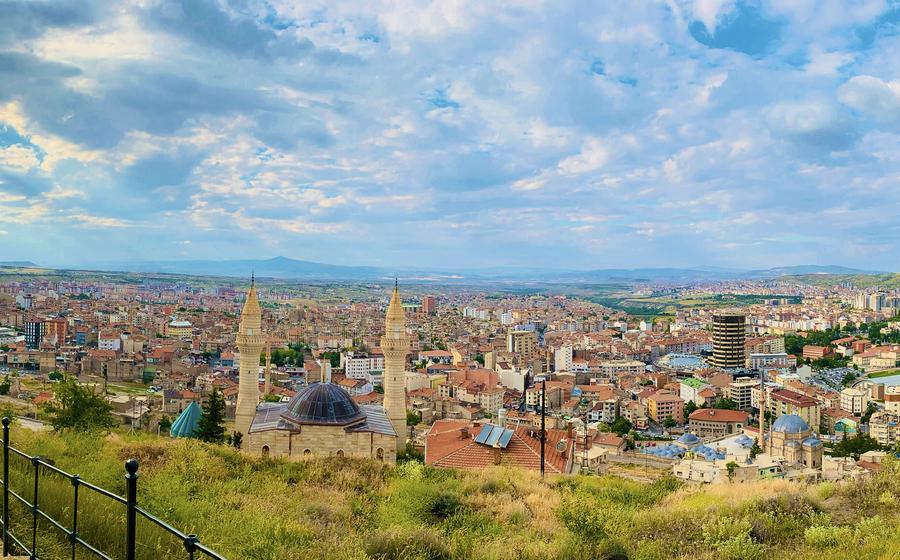
Venasa Underground City
- Historical Background: Unearthing Ancient Mysteries
- Location and Accessibility
- Admission and Tours
- Exploring the Underground City
- Residential Quarters
- Religious Spaces
- Defensive Structures
- Water Supply and Storage
- Food Storage and Production
- Ventilation and Air Quality
- Archaeological Discoveries
- Legends and Folklore
- Tips for Visitors:
- Insider Tip:
Historical Background: Unearthing Ancient Mysteries
The Venasa Underground City, nestled within the heart of Nevşehir, Turkey, stands as a testament to the ingenuity and resilience of ancient civilizations. Its origins shrouded in mystery, the city is believed to have been constructed by the Hittites, an Anatolian people who ruled the region during the Bronze Age. Theories abound regarding its intended purpose, with some suggesting it served as a refuge during times of war or religious persecution, while others propose it was a thriving underground community, hidden from the watchful eyes of invaders. Legends passed down through generations speak of a secret passage leading to a hidden chamber where treasures of immense value were once stored, fueling the imaginations of adventurers and history enthusiasts alike.
Location and Accessibility
The Venasa Underground City is located in the historical region of Cappadocia, in the province of Nevşehir, Turkey. It lies approximately 45 kilometers south of the city of Nevşehir and is easily accessible by road. To reach the underground city, visitors can take a bus or rent a car from Nevşehir or nearby cities like Ürgüp and Göreme. The drive takes about an hour through scenic landscapes and traditional Turkish villages. Once you arrive at the site, there is ample parking space available for visitors.
Admission and Tours
Visiting the Venasa Underground City offers an immersive experience into the past, taking you back to a time when communities thrived beneath the earth's surface. To fully appreciate the wonders of this subterranean marvel, guided tours are highly recommended. These tours are led by knowledgeable and experienced guides who will provide insights into the history, construction, and daily life of the ancient inhabitants.
Admission fees are reasonable, ensuring that this unique attraction is accessible to all. Several tour options are available, catering to different interests and time constraints. Standard tours typically last for around 45 minutes to an hour and cover the main highlights of the underground city, including the tunnels, rooms, churches, and defensive structures.
Longer tours, lasting up to two hours, offer a more in-depth exploration, venturing into hidden chambers and providing detailed explanations of the city's fascinating history. Whether you choose a standard or extended tour, the guides will captivate you with stories and anecdotes that bring the underground city to life, making your visit an unforgettable experience.
Exploring the Underground City
Descending into the Venasa Underground City is like stepping back in time. The ancient tunnels and rooms, carved from soft volcanic rock, create a labyrinthine network that once housed a thriving community. The layout of the city is well-organized, with interconnected tunnels leading to various rooms and chambers. These spaces served different purposes, from living quarters and storage areas to religious sites and defensive structures.
As you navigate through the underground city, you'll marvel at the ingenuity of its design. The tunnels are narrow and winding, often requiring visitors to duck or crouch as they explore. This intricate layout was intentional, as it made it difficult for invaders to navigate the city and provided multiple defensive points.
One of the most striking features of the underground city is its ventilation system. Small air shafts and chimneys, cleverly positioned throughout the tunnels, allowed for fresh air to circulate and remove harmful gases. This was crucial for maintaining a healthy environment for the inhabitants, who spent extended periods underground.
Another remarkable aspect of the city is its water supply system. The inhabitants relied on rainwater for survival, collecting it in large cisterns carved into the rock. These cisterns were carefully designed to filter and store water, ensuring a clean and reliable supply for the community.
Residential Quarters
Within the depths of the Venasa Underground City, a remarkable glimpse into the daily lives of its ancient inhabitants can be found in the residential quarters. These spaces, carved meticulously into the soft rock, served as functional living areas for the city's dwellers.
Sleeping Areas:
The sleeping quarters, though modest in size, provided essential comfort and privacy for the city's residents. Alcoves and niches carved into the walls served as beds, offering a sense of separation and seclusion within the communal living spaces.
Cooking Facilities:
Cooking facilities, though basic, were cleverly designed to accommodate the needs of the community. Fireplaces and ovens, built into the walls, provided warmth and a means to prepare meals. These communal cooking areas fostered a sense of togetherness and cooperation among the inhabitants.
Storage Spaces:
Storage spaces, an integral part of the residential quarters, ensured the preservation of food and other essential supplies. Carefully carved niches and cavities provided ample space for storing grains, dried fruits, and other provisions, ensuring sustenance during times of scarcity or conflict.
Religious Spaces
Within the depths of the Venasa Underground City, a sense of spirituality permeates the air. Churches and chapels, carved into the soft volcanic rock, served as sanctuaries for the city's inhabitants. These sacred spaces provided solace and a connection to the divine in a world shrouded in darkness.
The churches, often small and intimate, feature intricate carvings and frescoes depicting biblical scenes and revered saints. These works of art, created by skilled artisans, added a touch of beauty and inspiration to the otherwise austere surroundings. The chapels, on the other hand, were simpler in design, offering a quiet space for prayer and contemplation.
The presence of religious spaces within the underground city underscores the importance of faith in the lives of its inhabitants. In times of adversity and uncertainty, they sought comfort and guidance from their beliefs, finding strength and resilience in their shared spirituality. These religious spaces served as a symbol of hope, reminding them of the divine presence that watched over them even in the darkest of times.
Defensive Structures
Security was paramount to the inhabitants of the Venasa Underground City. To protect themselves from potential threats, they employed several innovative defensive measures. Secrecy was the first line of defense. Hidden entrances, often disguised as ordinary houses or stables, allowed residents to enter and exit the city undetected. Once inside, a labyrinth of narrow tunnels and secret passages made navigation difficult for intruders.
Traps and pitfalls were strategically placed throughout the city to deter unwanted visitors. Heavy stones suspended from ropes could be released to block tunnels or crush unsuspecting trespassers. In some areas, the floor could be triggered to collapse, sending intruders into a hidden pit below.
The city's ventilation system also played a role in defense. It could be manipulated to create smoke screens or release noxious fumes, effectively disorienting and incapacitating attackers.
Water Supply and Storage
The Venasa Underground City exhibited remarkable ingenuity in managing its water supply. The inhabitants constructed an elaborate network of water cisterns to store and distribute water throughout the city. These cisterns were strategically placed at various points within the underground complex, ensuring a reliable water source for all residents.
The water collection system relied on natural springs and rainwater. Channels and conduits were built to direct water from these sources into the cisterns. The cisterns were then sealed to prevent contamination and evaporation. To maintain the water's purity, the city employed a filtration system that removed impurities and ensured the water was safe for consumption.
The water storage capacity of the Venasa Underground City was truly impressive. The cisterns were designed to hold a substantial amount of water, allowing the city to sustain itself during periods of drought or siege. This foresight and engineering prowess ensured that the inhabitants had access to a vital resource, even in times of scarcity.
Food Storage and Production
The inhabitants of the Venasa Underground City exhibited remarkable resilience and ingenuity in securing their food supply within the confines of their subterranean dwelling. They employed various techniques to store and preserve food to ensure sustenance during extended periods of isolation.
One of their primary methods involved utilizing cleverly designed storage spaces within the city's chambers. These spaces were strategically positioned to maintain optimal temperature and humidity levels, creating ideal conditions for storing perishable goods. The inhabitants also employed natural preservation methods such as salting, drying, and smoking to extend the shelf life of their food supplies.
Subterranean agriculture played a crucial role in providing fresh produce for the city's inhabitants. They skillfully cultivated edible plants and mushrooms within the underground environment, utilizing available light sources and creating controlled growing conditions. These agricultural practices supplemented their diet and provided essential nutrients during times of isolation.
The inhabitants also engaged in animal husbandry, raising livestock such as chickens and goats within the confines of the underground city. These animals provided a steady source of meat, milk, and eggs, ensuring a diverse and nutritious diet.
By combining these innovative food storage and production techniques, the inhabitants of the Venasa Underground City demonstrated their remarkable ability to adapt and thrive in a challenging and isolated environment. Their ingenuity and resourcefulness allowed them to maintain a sustainable food supply and uphold a vibrant community within the depths of the earth.
Ventilation and Air Quality
Maintaining a breathable atmosphere within the subterranean confines of the Venasa Underground City was of paramount importance for its inhabitants. To ensure a continuous supply of fresh air and the removal of harmful gases, the city's architects employed ingenious ventilation systems.
A network of interconnected tunnels and shafts served as the city's lungs, allowing air to circulate throughout its chambers and corridors. Strategically placed air vents and chimneys provided additional channels for the exchange of air, drawing in fresh oxygen from the surface and expelling stale air and smoke.
The city's builders also incorporated natural ventilation principles into their designs. By positioning certain rooms and passageways along prevailing wind currents, they maximized the flow of fresh air through the underground spaces.
This sophisticated ventilation system not only sustained the health and well-being of the city's inhabitants but also played a crucial role in preventing the buildup of toxic gases, such as carbon monoxide and methane, which could have posed a significant threat in the enclosed environment.
Archaeological Discoveries
Archaeological excavations within the Venasa Underground City have unearthed a wealth of artifacts, tools, and pottery that provide valuable insights into the daily lives of its inhabitants. These discoveries include ceramic vessels, cooking utensils, storage jars, and agricultural implements. Among the most notable finds are clay seals bearing various symbols and inscriptions, which suggest the existence of a sophisticated administrative system within the city. Furthermore, the discovery of coins, jewelry, and religious artifacts sheds light on the economic and cultural activities that took place there. These archaeological findings collectively contribute to our understanding of the city's history, its inhabitants' way of life, and the broader context of Byzantine and early Christian society in Cappadocia.
Legends and Folklore
The Venasa Underground City is steeped in local legends and folklore, adding an enchanting layer to its history. One popular tale tells of a secret tunnel that connects the city to the nearby Ihlara Valley, a scenic gorge known for its churches and monasteries. Legend has it that the tunnel was used by the city's inhabitants to escape in times of danger or to transport goods and supplies. Another legend speaks of a hidden treasure buried somewhere within the underground city, guarded by a fierce dragon. Treasure hunters have searched for centuries, but no one has ever found it. These stories and legends have been passed down through generations, captivating the imaginations of locals and visitors alike. They not only preserve the history of the city but also contribute to its enduring mystique and allure.
Tips for Visitors:
To make the most of your visit to the Venasa Underground City, consider the following tips:
-
Dress appropriately: Wear comfortable shoes as you will be doing a lot of walking on uneven surfaces. Light layers of clothing are recommended to adjust to changing temperatures within the city.
-
Bring essentials: Carry a flashlight or headlamp for exploring darker areas, as well as a camera to capture the unique sights. A bottle of water and snacks are also advisable.
-
Be cautious: Watch your step and mind your head as the tunnels can be narrow and low in places. Be aware of uneven surfaces and potential tripping hazards.
-
Plan your visit: Aim to arrive early in the day to avoid crowds and heat. Guided tours are available and recommended to learn more about the city's history and significance.
-
Choose the right time: While the underground city is open year-round, the best time to visit is during the spring or fall when the weather is mild and comfortable.
Insider Tip:
For an unforgettable experience, time your visit to the Venasa Underground City during the annual Nevşehir Underground City Festival. Held in the summer, this vibrant festival brings the ancient city to life with traditional music, dance performances, and reenactments of daily life in the underground dwellings. It's a unique opportunity to immerse yourself in the history and culture of Cappadocia and gain a deeper appreciation for the ingenuity and resilience of its ancient inhabitants.
